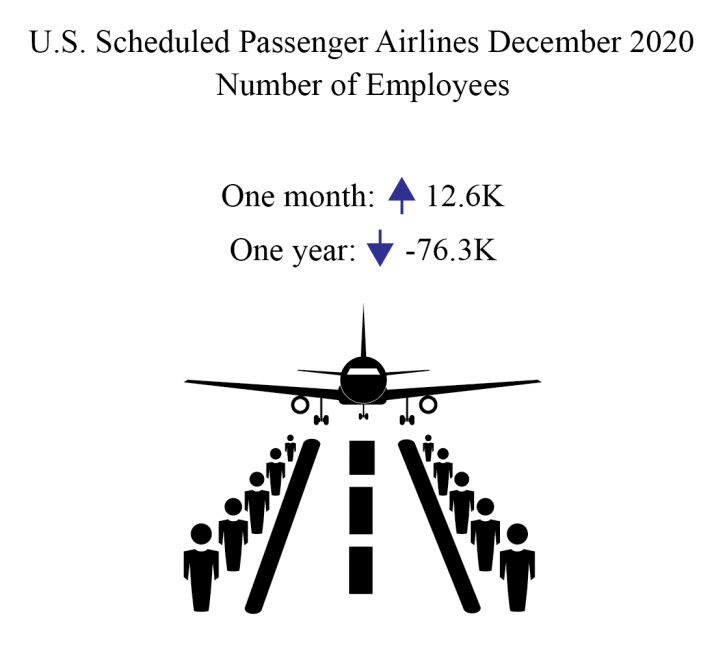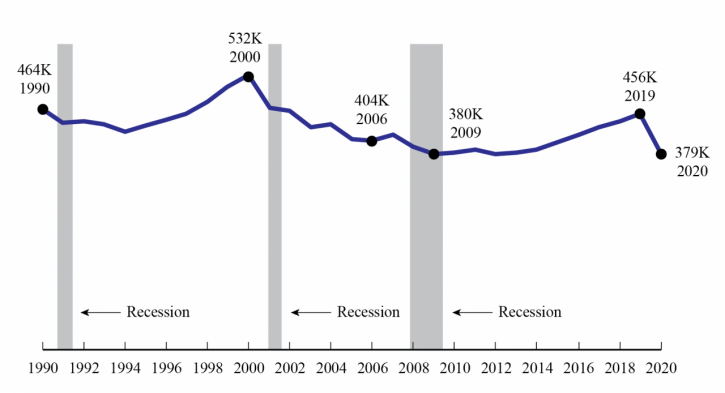Mid-December 2020 U.S. Passenger Airline Employment Up Nearly 13,000 FTEs from Mid-November
Release Number: BTS 13-21

The 17 U.S. scheduled passenger airlines employed 3.4% more full-time equivalents (FTEs) in mid-December 2020 than in mid-November 2020:
- Mid-December’s total number of FTEs (379,302) was up 12,552 from mid-November (366,750 FTEs) and down 80,731 from mid-March 2020 (460,033). December was the lowest FTE total for the month of December in Bureau of Transportation Statistics (BTS) records dating from January 1990. The previous record low for December was in 2009 (379,698).
- Mid-December FTEs were down 76,264, a 16.7% drop from mid-December 2019 (455,566).
In mid-December, scheduled passenger airlines employed 60% of the total airline industry FTEs, down from 66% in March 2020. Total industry FTEs, released on Feb. 9, rose 15,055 FTEs (2.4%) from November to December. Total industry includes cargo and charter.
Regulations require U.S. airlines to report employment numbers for employees who worked or received pay for any part of the pay period(s) ending nearest the 15th day of the month. U.S. airline employment reports are filed monthly with the Bureau of Transportation Statistics. See the tables that accompany this release on the BTS website for detailed data since 2015 (Tables 1-15) and industry summary monthly data since 1990. Airlines receiving funds under the CARES Act were prohibited from layoffs or furloughs until Sept. 30.

Employees at U.S. Scheduled Passenger Airlines Month of December, 1990-2020
| December FTEs in thousands (000) | |
|---|---|
| 1990 | 464.1 |
| 1991 | 440.4 |
| 1992 | 441.0 |
| 1993 | 438.0 |
| 1994 | 423.3 |
| 1995 | 433.8 |
| 1996 | 446.4 |
| 1997 | 455.5 |
| 1998 | 481.1 |
| 1999 | 508.1 |
| 2000 | 531.9 |
| 2001 | 467.0 |
| 2002 | 462.6 |
| 2003 | 431.1 |
| 2004 | 436.9 |
| 2005 | 408.9 |
| 2006 | 404.2 |
| 2007 | 417.3 |
| 2008 | 391.8 |
| 2009 | 379.7 |
| 2010 | 380.4 |
| 2011 | 386.9 |
| 2012 | 379.7 |
| 2013 | 380.8 |
| 2014 | 386.2 |
| 2015 | 401.4 |
| 2016 | 416.3 |
| 2017 | 430.6 |
| 2018 | 442.0 |
| 2019 | 455.6 |
| 2020 | 379.3 |
All 17 scheduled service passenger airlines (mid-December)
- 379,302 FTEs
- Down 16.7% (76,264 FTEs) from December 2019 (455,566 FTEs)
- Down 8.9% (37,035 FTEs) from December 2016 (416,337 FTEs)
Four network airlines (mid-December)
- 228,849 FTEs, 60.3% of total scheduled passenger airline FTEs
- Down 20.9% (60,310 FTEs) from December 2019 (289,159 FTEs)
- Down 16.1% (43,765 FTEs) from December 2016 (272,614 FTEs)
- Up 5.0% (10,876 FTEs) from mid-November 2020 (217,973 FTEs)
- Down 21.4% (62,360 FTEs) from mid-March 2020 (291,209 FTEs)
Network airlines operate a significant portion of their flights using at least one hub where connections are made for flights to down-line destinations or spoke cities. Note that beginning with January 2018 data, Virgin America’s numbers are included with Alaska Airlines in the network category.
Five low-cost airlines (mid-December)
- 91,663 FTEs, 24.2% of total scheduled passenger airline FTEs
- Down 6.2% (6,050 FTEs) from December 2019 (97,713 FTEs)
- Up 7.3% (6,229 FTEs) from December 2016 (85,434 FTEs)
- Down 0.3% (242 FTEs) from mid-November 2020 (91,905 FTEs)
- Down 7.0% (6,868 FTEs) from mid-March 2020 (98,531 FTEs)
Low-cost airlines operate under a low-cost business model, with infrastructure and aircraft operating costs below the overall industry average.
Eight regional airlines (mid-December)
- 51,268 FTEs, 13.5% of total scheduled passenger airline FTEs
- Down 15.2% (9,155 FTEs) from December 2019 (60,423 FTEs)
- Up 1.3% (652 FTEs) from December 2016 (50,616 FTEs)
- Up 2.9% (1,463 FTEs) from mid-November 2020 (49,805 FTEs)
- Down 16.0% (9,735 FTEs) from mid-March 2020 (61,003 FTEs)
Regional carriers typically provide service from small cities, using primarily regional jets to support the network carriers’ hub and spoke systems.
Top Employers by Group
- Network: American 94,712 FTEs
- Low-Cost: Southwest 56,537 FTEs
- Regional: SkyWest 16,739 FTEs
Four other airlines
Other carriers generally operate within specific niche markets. They are: Hawaiian Airlines, Sun Country Airlines, Silver Airlines and Eastern Airlines.
Reporting Notes
Airlines that operate at least one aircraft that has more than 60 seats or the capacity to carry a payload of passengers, cargo and fuel weighing more than 18,000 pounds must report monthly employment statistics.
Data are compiled from monthly reports filed with BTS by commercial air carriers as of Feb 8. Additional airline employment data and previous releases can be found on the BTS website. BTS has scheduled release of January 2021 passenger airline employment data for March. 17.
